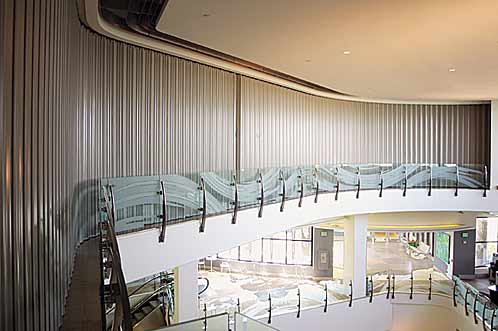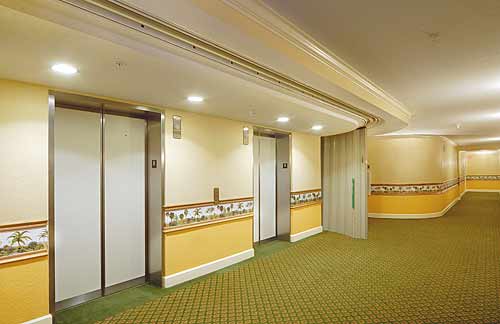Horizontal Sliding Fire Doors: Code-Compliant Design for Wide-Span Opening Protectives
The systems are well suited for museums that require this function and are in place at the Smithsonian and several dozen other museums, art institutes, and performing arts centers.
Airports face a similar but slightly more practical design challenge: they must accommodate the rapid movement of thousands of patrons while complying with life safety requirements and building security. Horizontal accordion-style sliding doors can emerge from recessed walls and seal off openings as large as 60 feet, as is the case at Orlando International Airport. The systems are in use at the major airports in New York, Washington, Chicago, Newark, Houston, Miami, and Los Angeles, as well as others.
Government facilities have seen a dramatically increased need for building security in the wake of the September 11, 2001 terrorist attacks on New York and Washington. At the Pentagon, where American Airlines Flight 77 slammed into the side of the building and killed 125 occupants, 38 horizontal accordion-style sliding doors were in place in the building's vast network of corridors.
They were there in part because conventional swinging doors at the end of long corridors were cumbersome for the electric carts that were used to transport paperwork and supplies. Some of these doors in the 26-foot-wide corridors had actually been chained open.
On September 11, the sliding-door systems took on new significance, activating instantly at the signal of alarm. One general recalled that he saw a fireball racing down a corridor and felt certain he would perish, but the horizontal sliding door drew shut, sealing off the inferno and allowing him to escape.
Courthouses that require free-flowing access for judges and attorneys but need to be similarly sealed off in a security emergency have also turned to the systems as a design solution.
Public Venues and Places of Assembly
Sliding-door systems are also in use at hotels including Walt Disney World, the Hyatt, Hilton, Marriott, Fairmont, Ritz-Carlton, and Intercontinental chains, around atriums and as a retractable protective barrier around elevator lobbies, needed to prevent the vertical migration of fire. They are commonly used in sports facilities for football, baseball, basketball and hockey, where large numbers of fans must pass through openings and corridors that must be sealed off in an emergency while still providing emergency egress.
|
Shopping malls, with their distinctive fire safety and security requirements, use horizontal sliding-door systems as long as 100 feet, which curve and snake along the line of the desired protective barrier. At virtually every gaming facility in Las Vegas, the systems take the place of conventional swinging doors that limit design flexibility and can be cumbersome for large numbers of guests moving between spaces. At Caesar's Palace, the system serves as a fire-assembly separator, between the casino and the shopping center.
At hundreds of Wal-Mart stores, the sliding-door systems serve as emergency egress in back storage areas. Some of the emergency exits are required to be in the back of the large stores, and in the event that front entrances are inaccessible, patrons need to be moved through the storage areas. But the storage and stockroom areas typically have high ceilings and require large openings to get products in and out; the sliding-door systems serve that function but also provide emergency egress and fire protection. The systems are in use at other large stores such as Nordstrom, Macy's, Target, and Sears, and also in smaller sales areas in stores such as Banana Republic and Brooks Brothers.
|
Designers of hospitals, specialized health-care facilities, and assisted-living complexes have also increasingly turned to the sliding-door solution, particularly as the design of interior spaces (i.e., expansive foyers, atriums, and gathering spaces that take advantage of natural lighting) has been linked to the psychological well-being of patients. The retractable systems facilitate interiors that are open and airy rather than stark and sterile. The same is true in educational institutions, where stringent fire and building code requirements can sometimes compromise architectural quality with unsightly permanent barriers. The systems are in use at university facilities from Harvard and Duke to Michigan and Stanford.
New applications are also seen in convention centers, theatres, parking garages, subway systems, and a wide variety of office buildings.











